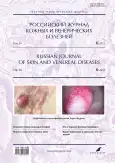Experience of using benzoyl peroxide and clindamycin gel in the treatment of mild and moderate acne
- Authors: Olisova O.Y.1, Shepeleva A.V.1, Kayumova L.N.1
-
Affiliations:
- I.M. Sechenov First Moscow State Medical University (Sechenov University)
- Issue: Vol 26, No 6 (2023)
- Pages: 605-622
- Section: DERMATOLOGY
- URL: https://journal-vniispk.ru/1560-9588/article/view/254771
- DOI: https://doi.org/10.17816/dv611037
- ID: 254771
Cite item
Abstract
BACKGROUND: Acne is an actual problem for both patients and doctors of different specialties, especially dermatovenerologists and cosmetologists. Up to 85% of young people are affected by the disease. Skin lesions on the face and lack of effect of previously administered therapy are often accompanied by severe psychosocial maladjustment even in mild forms of dermatosis. In addition, recently there has been a tendency towards increased resistance of Cutibacterium acnes to antibacterial agents, which requires the development of drugs, including those to prevent antibiotic resistance.
AIM: Clinical and morphofunctional assessment of the effectiveness and tolerability of the Zerkalin Intensive gel (benzoyl peroxide and clindamycin) in patients with mild to moderate acne.
MATERIALS AND METHODS: the study involved 30 patients with acne (28 women and 2 men) aged 18 to 34 years, 4 of them had mild severity, 26 had moderate severity. All patients applied benzoyl peroxide and clindamycin gel once a day in the evening, the observation period was 12 weeks. Dermatological examination was carried out visually with a simple count of inflammatory lesions (papules, pustules). In order to assess the morphofunctional parameters of facial skin, all patients underwent a non-invasive digital study using the Capricorn AI Intelligent Imager Bitmoji device, based on 3D visualization. To study the impact of the disease on various aspects of the patient's life and as an effectiveness criterion, the Dermatology life Quality Index (DLQI) was used.
RESULTS: in all patients using the benzoyl peroxide and clindamycin gel there was a regression of inflammatory and non-inflammatory elements and a decrease in post-acne phenomenon, while an improvement in the condition of the skin process was registered within the first 2–4 weeks. As a result of the treatment, complete cleansing of the skin was achieved in 8 patients, significant improvement in 17, and improvement in 5. At the end of the entire observation period, according to the questionnaire, the subjects observed a decrease in DLQI compared with the baseline (18.4±3.03 versus 3.03±0.15; p <0.05), which indicates an improvement of the quality of life and psychoemotional state of patients and the effectiveness of therapy.
CONCLUSION: Benzoyl peroxide and clindamycin gel for the treatment of mild to moderate acne is an effective remedy, especially with a predominance of pustular elements, which is confirmed based on the results of a visual examination and the positive dynamics of indicators of superficial and deep analysis of facial skin (sebumetry, corneometry, pigmentation, reactivity and level colonization by C. acnes). The gel was well tolerated by patients and did not cause any adverse events or allergic reactions.
Full Text
##article.viewOnOriginalSite##About the authors
Olga Yu. Olisova
I.M. Sechenov First Moscow State Medical University (Sechenov University)
Email: olisovaolga@mail.ru
ORCID iD: 0000-0003-2482-1754
SPIN-code: 2500-7989
MD, Dr. Sci. (Med.), Professor, Corresponding member of the Russian Academy of Sciences
Russian Federation, 4/1 Bolshaya Pirogovskaya street, 119991 MoscowAnastasia V. Shepeleva
I.M. Sechenov First Moscow State Medical University (Sechenov University)
Author for correspondence.
Email: dr.shepelevaavl@gmail.com
ORCID iD: 0009-0001-5251-5394
Russian Federation, 4/1 Bolshaya Pirogovskaya street, 119991 Moscow
Lyailya N. Kayumova
I.M. Sechenov First Moscow State Medical University (Sechenov University)
Email: avestohka2005@inbox.ru
ORCID iD: 0000-0003-0301-737X
SPIN-code: 4391-9553
MD, Cand. Sci. (Med.), Assistant Professor
Russian Federation, 4/1 Bolshaya Pirogovskaya street, 119991 MoscowReferences
- Russian Society of Dermatovenerologists and Cosmetologists. Federal clinical guidelines for the management of acne patients. Moscow; 2020. 20 p. (In Russ).
- Olisova OY. Modern approaches to the external therapy for acne. Dermatology. Consilium Medicum. 2008;(2):15–18. (In Russ).
- Borovaya AS, Olisova OY. Systemic isotretinoin therapy of acne vulgaris (review of literature). Russ J Skin Venereal Diseases. 2012;(5):47–51. (In Russ).
- Thielitz A, Krautheim A, Gollnick H. Update in retinoid therapy of acne. Dermatol Ther. 2006;19(5):272–279. doi: 10.1111/j.1529-8019.2006.00084.x
- Jugeau S, Tenaud I, Knol AC, et al. Induction of toll-like receptors by Propionibacterium acnes. Br J Dermatol. 2005;153(6):1105–1113. doi: 10.1111/j.1365-2133.2005.06933.x
- Halvorsen JA, Stern RS, Dalgard F, et al. Suicidal ideation, mental health problems, and social impairment are increased in adolescents with acne: A population-based study. J Invest Dermatol. 2011;131(2):363–370. doi: 10.1038/jid.2010.264
- An illustrated guide to dermatology. To prepare physicians for accreditation. Ed. by O.Yu. Olisova, N.P. Teplyuk. Moscow: GEOTAR-Media; 2023. 376 p. (In Russ).
- Ko HC, Song M, Seo SH, et al. Prospective, open-label, comparative study of clindamycin 1%/benzoyl peroxide 5% gel with adapalene 0.1% gel in Asian acne patients: Efficacy and tolerability. J Eur Acad Dermatol Venereol. 2009;23(3):245–250. doi: 10.1111/j.1468-3083.2008.02920.x
- Schaller M, Sebastian M, Ress C, et al. A multicentre, randomized, single-blind, parallel-group study comparing the efficacy and tolerability of benzoyl peroxide 3%/clindamycin 1% with azelaic acid 20% in the topical treatment of mild-to-moderate acne vulgaris. J Eur Acad Dermatol Venereol. 2016;30(6):966–973. doi: 10.1111/jdv.13541
- McKeage K, Keating GM. Clindamycin/benzoyl peroxide gel (BenzaClin): A review of its use in the management of acne. Am J Clin Dermatol. 2008;9(3):193–204. doi: 10.2165/00128071-200809030-00010
- Cunliffe WJ, Holland KT, Bojar R, Levy SF. A randomized, double-blind comparison of a clindamycin phosphate/benzoyl peroxide gel formulation and a matching clindamycin gel with respect to microbiologic activity and clinical efficacy in the topical treatment of acne vulgaris. Clin Ther. 2002;24(7):1117–1133. doi: 10.1016/s0149-2918(02)80023-6
Supplementary files




















